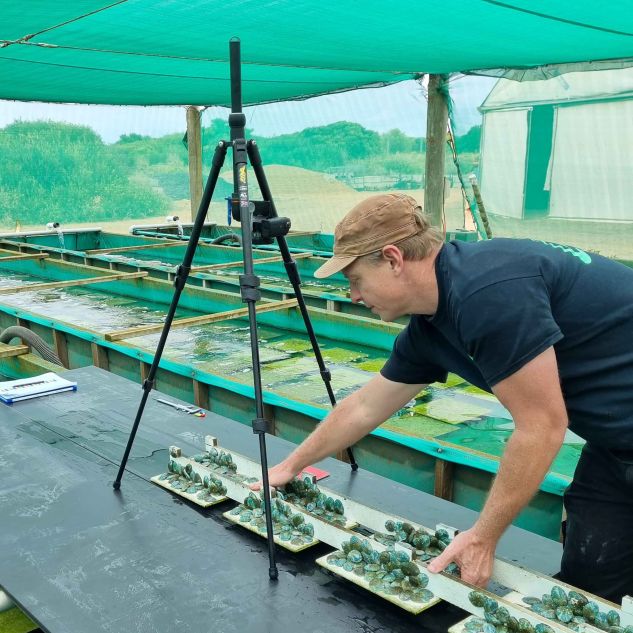
Written By
Tianna Killoran
College
College of Science and Engineering
Publish Date
27 July 2021
Related Study Areas
What do you get when you cross abalone with robots?
While blockbuster films may depict artificial intelligence (AI) as something in the distant future, one little creature is already getting a helping hand from AI machine learning. JCU researchers Professor Jan Strugnell, Professor Ickjai Lee, and PhD candidate Phoebe Arbon are each involved in funded research projects to use machine learning to help monitor and support the growth of farmed abalone populations.
The research came about through lively discussions with Australian abalone farmers. Phoebe says that following her Honours year at JCU, she and Jan went to present the findings of her research to the Australian Abalone Growers Association. In listening to the farmers’ frustration at monitoring the molluscs’ growth, the pair came up with a solution.
In 2020, Phoebe was awarded an Australian Science and Innovation Award for Young People in Agriculture, Fisheries, and Forestry, sponsored by the Fisheries Research and Development Corporation (FRDC). This award has funded Phoebe to develop machine learning to count and monitor the growth of abalone, particularly in the grow-out stage of production. Following this, Jan was awarded funding through the FRDC to assess abalone using AI as they progress through the nursery and weaner stages. Between these two projects, the researchers will be able to cover all of the abalone’s growth stages.
Phoebe says her interest in these small aquatic creatures came from childhood involvement in aquaculture. “When I was growing up, my family had a small scale freshwater fish farm, so I became interested at an early age. Then my interest grew further when I came to JCU and completed my Bachelor of Advanced Science,” she says.


Monitoring molluscs
So, why do we need to use AI to monitor abalone for farmers? Jan and Phoebe say that the regular process of counting abalone is very stressful for the little critters.
Abalone are a small marine mollusc with a shell on the outside. “They’re basically a massive suction cup that stick down on the bottom of the farm tanks,” Jan says. “So every time you want to measure or check the abalone you need to scrape it off the tank and measure it, and that’s an added stressor to the abalone. Some of them may die from the stress but for most this handling stress will impact the growth and physiology of the abalone.”
The importance of the team’s research with blacklip, greenlip and hybrid abalone cannot be highlighted enough. “Developing this AI technology allows us to remove this stressor on the abalone,” Jan explains.
Since farms have thousands of abalone stocked in hundreds of tanks, using AI to automate the monitoring and counting of the abalone will result in much faster and more accurate data collection from each of the tanks.
For these researchers, as well as the abalone farmers, the AI technology has many benefits. “It is also really time consuming to count abalone by hand,” Jan says. “The goal is to be able to capture images of the abalone in the tanks and the AI can predict their weight, size and distribution just from that.”
"Developing this machine learning is a super valuable process for farmers and saves them tens of thousands of dollars per year. It is way more accurate than humans doing the work. The benefits are innumerable."
Professor Jan Strugnell
Robots to the rescue
So, this little mollusc is now making friends with robots. Professor Ickjai is an expert in machine learning who has been working with Jan and Phoebe to teach the AI to monitor the abalone.
“Machine learning is a subset of artificial intelligence. It’s like teaching a little baby robot new skills,” Ickjai says. “We have to show the baby robot lots of images and feed it lots of data so it can learn to identify different things. It can learn to pick up patterns in the data and you can begin to automate certain processes.”
Ickjai explains that while developing the machine learning is very helpful for abalone farming, it also has applications in many industries. “Machine learning like in this project can be applied even in the food industry,” he says. “For instance, mango farmers have so many mangoes on all of their trees. Machine learning can help them to monitor their numbers and determine the best time to harvest. Pattern detectors can also take images or videos of the mangoes and classify the high-quality mangoes from the other sizes. This process is something that normally takes a lot of time and money to do by hand.”


A team effort
Giving a helping hand to these stressed-out abalone has required a team effort. While Phoebe is developing AI for stock monitoring during the grow-out stage, Jan has teamed up with Professor Ickjai Lee to use machine learning to help monitor and count the abalone in the earlier nursery and weaner stages.
Although the initial work to feed the machines the abalone data can be time consuming, the eventual progress makes up for the initial effort. “It is very labour intensive in the beginning until you can teach the robot how to do it for you,” Ickjai says.
“We had a number of students travel down to Melbourne to collect some data sets. The more data sets you have, the more you’re able to teach the AI. At the moment, typically around sixty to seventy per cent of our total project time is dedicated to data collection and labelling the data sets.”
But all of the effort will soon pay off, with the team developing a digital tool that will make the data collection even quicker. "With all of the hard work done by the research team, we'll soon be able to automate the data collecting in the abalone farms. It will make the process even more accurate and efficient," Ickjai says.